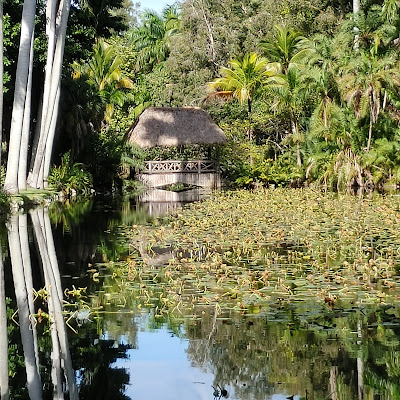 |
| Now that we had wheels, we headed off to see the Bonnet House. This home was designed by Frederic Bartlett (1873-1953) as a winter home and built in 1920. The house is plantation style, built around a central courtyard. Local materials such as Dade County pine, cypress and concrete blocks made from beach sand were used to construct the house. The property once belonged to Hugh Taylor Birch (1848-1943), who gave over 35 acres to his daughter, Helen (1882-1925) on the occasion of her marriage to Frederic Bartlett in 1919. The newlyweds began construction of Bonnet House, eager for a winter retreat where Frederic could pursue his artwork and Helen could compose music and poetry Tragedy struck in 1925 when Helen died from breast cancer. In 1931, Frederic Barlett married Evelyn Fortune Lilly (b. 1887). Their combined artistic talents are evident throughout Bonnet House. |
 |
| Go to the Bonnet House website and watch the videos about the estate. https://www.bonnethouse.org/about-all/ |
 |
| Double click to enlarge this map so you can see the details of the Bonnet House estate. Hwy A1A runs along the left (east) side of the map. Birch Street is at the bottom (north). |
 |
| Upon entering the front door, we were greeted by the lush foliage of the courtyard. |
 |
| The covered walkway surrounding the courtyard contained pieces of artwork many of which are replicas. |
 |
| Click on the photo to enlarge it so you can see the details of the home. |
 |
| Notice the painted ceiling. Next we entered the red doors to the studio |
 |
| I am unhappy that I didn't get a photo of the charcoal sketches that Frederick did before he had any formal training. They were life-like. |
 |
| After the studio we stepped back out to the courtyard. |
 |
| The courtyard also contained an aviary. Notice the New Orleans French Quarter-inspired balcony railing off the 2nd story. |
 |
| Continuing around the courtyard, we stepped into the Butler's Pantry. |
 |
| The door from the courtyard is to the right and the room to the left of this cabinet is the dining room. |
 |
| The open top of a dutch door let us look into the kitchen. |
 |
| 1930's electric icebox |
 |
| Turning our backs to the kitchen we start toward the dining through the door to the right of this cabinet. |
 |
| Cabinets built into the wall |
 |
| Stepping back out to the walkway we turn to the left to the north loggia. |
 |
| The entry to the veranda is blocked off by this very pretty gold gate. |
 |
| Ceiling |
 |
| Stepping into the south loggia, we see another fantastic ceiling. From here we enter the Drawing Room. |
 |
| Most of the decor, including the doors, was fashioned by the Barletts. |
 |
| Frederick Bartlett, surrounded by his wife, Evelyn, his son from his first marriage and his grandchildren. |
 |
| We weren't allowed to enter the Music Room but could peek through the plexiglass. |
 |
| Several iguanas were also enjoying the sunshine as they lounged around the pond. |
 |
| Next we headed out to a building that housed a shell collection, the Bamboo Bar and the Orchid collection. |
 |
| The shell collection occupied cabinets built into a circular room |
 |
| The Bamboo Bar. |
 |
| The Orchid Room. |
 |
| Next we walked to the Caretaker's Cottage. Saw this large bunch of keys hanging on the wall and thought how much digging it would take to find the key you needed. |
 |
| Some of the Cottage had been made into a gift shop because what attraction isn't complete without one. |
 |
| Yeap this unusually named tree actually exists |
 |
| Gumbo Limbo tree |
 |
| Next we walked the path to the east of the home. This path crossed over the slough and gave us a look at the Chickadee Bridge. |
 |
| On the other side of the slough, the land was undeveloped and in a more natural state. |
 |
| The canopy over the veranda isn't normally there. |
 |
| The most entertaining thing was the people crossing the AIA when they didn't have the right-of-way. I wonder how many get hit every year. |
 |
| One of the many lifeguard stations along the 24-mile of beach. |
 |
| On the way back to our hotel, we stopped into a grocery store and stocked up on edibles since we had a refrigerator and microwave. Another night we picked up chicken and baked beans at the store. |























































No comments:
Post a Comment